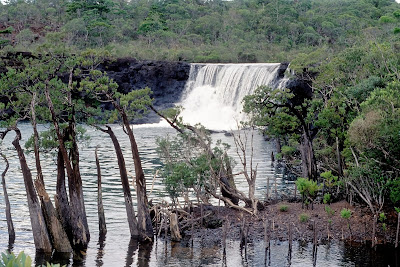Xanthostemon is a hot plant
In July 2003 I visited New Caledonia, an island of botanical treasures. I was there to collect red algae (one of those treasures) in the mountain streams, including the Chute de La Madeleine, about 100 km south of the capital Noumea. (In the foreground of this picture I took of the 'chute' is the New Caledonia Corkwood, Retrophyllum minor, a rare podocarp restricted to this area).
It just so happens this is also where some of the more intriguing plants hang out, include relatives of familiar Australian plants in the families Myrtaceae and Proteaceae. The soil is rich in nickel and other metals, giving it a deep red hue and the classification ultramafic (meaning low in silica and high in minerals).
It just so happens this is also where some of the more intriguing plants hang out, include relatives of familiar Australian plants in the families Myrtaceae and Proteaceae. The soil is rich in nickel and other metals, giving it a deep red hue and the classification ultramafic (meaning low in silica and high in minerals).
This was one year before I bought my first digital camera but some years ago I scanned just one of the plant photos, using it as a reminder of that spectacular flora. This is the photo, of Xanthostemon aurantiacus. (You can also see this species in the Southwest Pacific Island Collection, down by Nymphea Lily Lake in Melbourne Gardens.)
Ferdinand Mueller described the genus Xanthostemon in 1857, from material collected in tropical Australia. So it was with some pleasure in October 2016 I saw and photographed Xanthostemon paradoxus, the very species Mueller collected, during a warm walk through Litchfield National Park (which is curiously about as far from Darwin as Chute de La Madeleine is from Noumea).
Mueller found his Xanthostemon pardoxus near the Victoria River, further east, and the species is relatively common across the top of Western Australia and Northern Territory. There are now known to be 45-50 species of Xanthostemon, 13 or 14 in Australia and the rest distributed throughout Pacific Islands and nearby south-east Asia.
All species have a woody fruits and mostly yellow stamens (the stiff brush-like parts of the flower topped with the pollen bearing anthers). Xanthostemon paradoxus carries the rather odd common name of Bridal Tree as well as various names from local Indigenous languages, including sometimes the apparently cross-cultural, Northern Penda,
Back in the 1950s, this species was discovered to be a 'uranium accumulator' and just recently it was mentioned again as a plant that may warrant further investigation for biogeochemical prospecting. The ease at which the uranium was washed from the leaves led to some concern in the original study that the relatively high amounts found in leaves might be due to contamination at the site rather than the plant drawing uranium up from the soil.
In terms of the species being used to locate underground deposits, presumably this also depends on whether Bridal Tree favours areas rich in uranium or simply accumulates the mineral when growing in uranium-rich soils, Do you simply map where the plant grows or do you have to grind up the leaves of each population to find out whether it's growing above uranium? Alternatively you might 'mine' the minerals directly from the plants themselves, which may be possible one day.
In any case, a brush of yellow anthers might be a hint that yellow rock is nearby. But to finish, three pictures of a third species of Xanthostemon, only found in the Northern Territory, and here nestled beside Tolmer Falls in Litchfield National Park. It's called Xanthostemon eucalyptoides, although in leaf, apart from the lack of black hairs, I would have named it Xanthostemon 'angophora-hispida-oides'...
Mueller found his Xanthostemon pardoxus near the Victoria River, further east, and the species is relatively common across the top of Western Australia and Northern Territory. There are now known to be 45-50 species of Xanthostemon, 13 or 14 in Australia and the rest distributed throughout Pacific Islands and nearby south-east Asia.
All species have a woody fruits and mostly yellow stamens (the stiff brush-like parts of the flower topped with the pollen bearing anthers). Xanthostemon paradoxus carries the rather odd common name of Bridal Tree as well as various names from local Indigenous languages, including sometimes the apparently cross-cultural, Northern Penda,
Back in the 1950s, this species was discovered to be a 'uranium accumulator' and just recently it was mentioned again as a plant that may warrant further investigation for biogeochemical prospecting. The ease at which the uranium was washed from the leaves led to some concern in the original study that the relatively high amounts found in leaves might be due to contamination at the site rather than the plant drawing uranium up from the soil.
In terms of the species being used to locate underground deposits, presumably this also depends on whether Bridal Tree favours areas rich in uranium or simply accumulates the mineral when growing in uranium-rich soils, Do you simply map where the plant grows or do you have to grind up the leaves of each population to find out whether it's growing above uranium? Alternatively you might 'mine' the minerals directly from the plants themselves, which may be possible one day.
In any case, a brush of yellow anthers might be a hint that yellow rock is nearby. But to finish, three pictures of a third species of Xanthostemon, only found in the Northern Territory, and here nestled beside Tolmer Falls in Litchfield National Park. It's called Xanthostemon eucalyptoides, although in leaf, apart from the lack of black hairs, I would have named it Xanthostemon 'angophora-hispida-oides'...










Comments